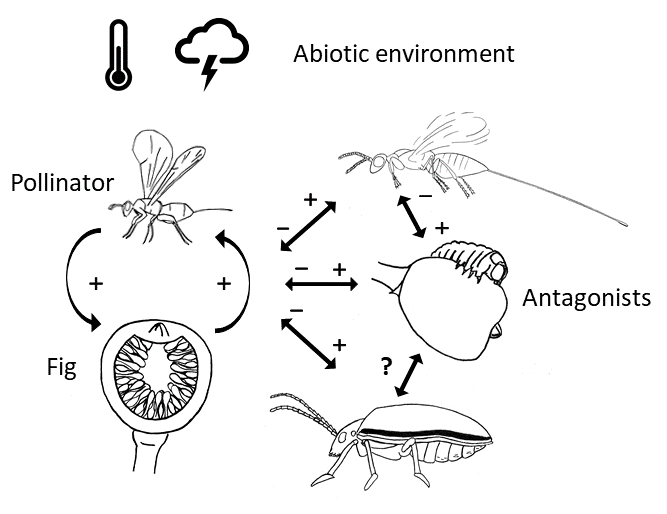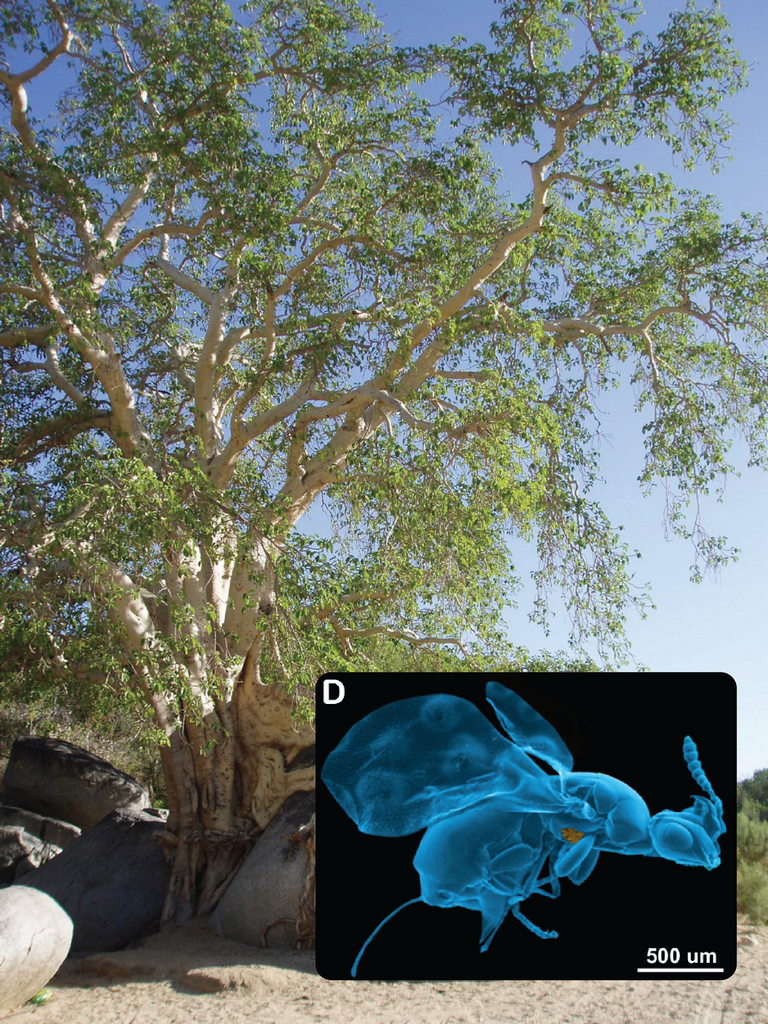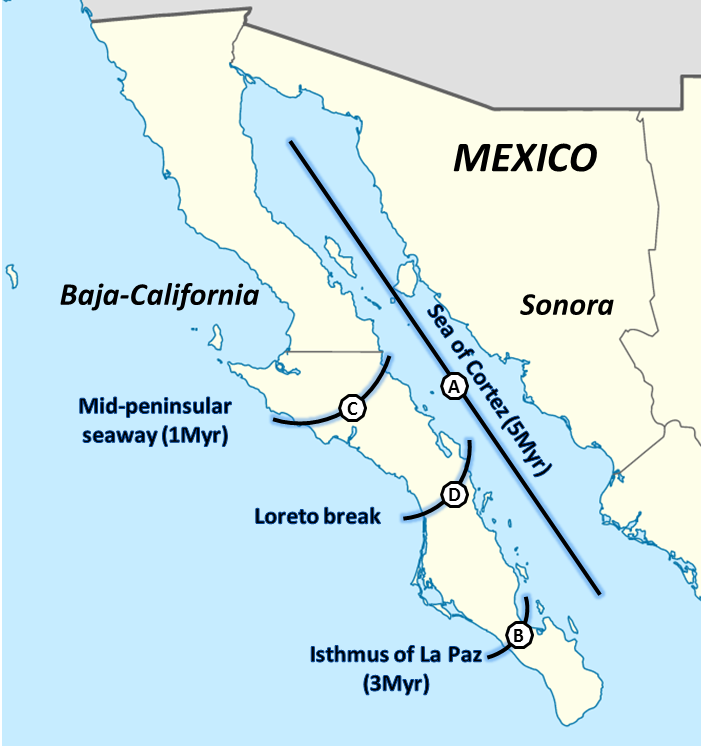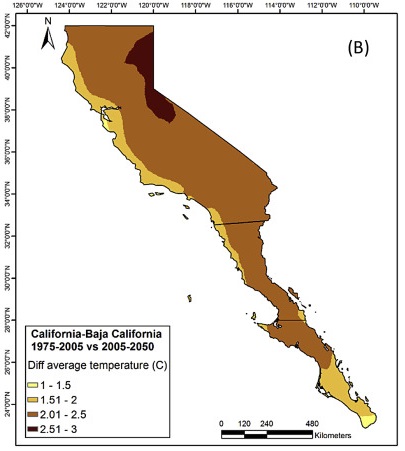
All living organisms on Earth interact with others. Whether these interactions are antagonistic, competitive, mutualistic, neutral,
commensal or amensal, symbiotic or asymbiotic, obligate or facultative, as well as various combinations between these spectra,
we all
live surrounded by biological entities. In order to understand the ecology and evolution of living organisms, one must
consider all essential factors that influence their life history traits.
The ecological niche of species is multidimensional
and includes both biotic and abiotic elements. Among all species interactions, those that have been essentially ignored in past
centuries are mutualisms, reciprocally beneficial interactions between species.
Mutualisms however are extremely common and provide essential ecosystem services. My scientific interests lie in the
study of evolutionary and ecological aspects of species interactions, particularly in how mutualisms proceed in a multidimensional
context that includes variation in their abiotic environment as well as the influential species with which they interact in the context of global change.
A desert fig-fig wasp mutualism

In the Nason lab, we are interested in
fig-fig wasp mutualisms. I am currently
studying how variation in biotic and abiotic factors affect Ficus petiolaris,
a desert rock strangling fig tree and its associated insects in Baja California, Mexico: one pollinating species (Pegoscapus sp.) and several antagonists.
More specifically, by using observational approaches and multivariate statistical methods, I aim to test hypotheses
that suggest potential relationships between the insects, ecological factors related to the biology of host tree
(reproductive phenology, fig characteristics, tree density, etc.) as well as temperature and rainfall. To address these
hypotheses, the Nason team sampled and measured the appropriate variables across several populations of the peninsula during
four seasonal field trips. Daily site-specific climate data were obtained from global estimates generated by
MODIS and CHIRPS
using satellite imagery. My primary results suggest strong variation among sites and seasons, and a strong influence
of both biotic and abiotic environmental factors on the fig-fig wasp-antagonists system, particularly climate variables.
(Electron microscopy of Pegoscapus sp. from Piedra-Malagón et al. 2018: source)

Deoxyribonucleic acid (DNA) is the universal component of living organisms and the physical basis of a very large amount of genetic
information. Thanks to significant advances in sequencing
technology, population genetics
and phylogenetics, it is now possible to infer the shallow and deep demographic histories of species. Mexico is one of the most
biodiverse countries in the world.
It has high ecosystem diversity and a rich geological history, particularly the Baja California peninsula which experienced several
major geological events, that potentially affected the demography of Mexican species. F. petiolaris’s is the
northernmost endemic fig species in the New World, yet its history
is unknown. I am interested in investigating how past geological and major climatic events have shaped the current genetic diversity
of F. petiolaris as well as infer its past demography. This research will lay the groundwork for a larger comparative
phylogeography project between the host fig tree and many associated organisms (wasps, other antagonistic insects, nematodes) which
will be conducted with Kevin Quinteros
and John Nason.

The rapid human driven environmental changes currently occurring are predicted to drastically affect Baja California in the near future. Several
studies have presented future climate models in the region that predict an increase of temperature and a reduction of precipitation particularly
affecting the northern part of the peninsula. Both of these climate factors are known to have major influences on living organisms, in particular
insects. In the fig-fig wasp case, recent experiments have
shown that fig wasps’ lifespans are greatly reduced above 35°C and limited to a couple of hours around 40°C. Thus, it is legitimate to wonder how the
climate change in Baja California will impact the fig-fig wasp mutualism and when. From this information and the results obtained by estimating past
and present effects of the climate on the fig-fig wasp-antagonists system and using correlative modeling, I hope to have a global view on the system
and project the changes in the species distributions, community compositions and interactions based on future climate models. The results could potentially greatly
improve our estimation of species interaction outcomes in a changing world and highlight potential conservation priorities. (Figure from Vaghefi et al. 2017:
source)
Mutualisms and their ecosystem services in a changing world
Mutualism and facilitation are ubiquitous in our world, however their beneficial effect on natural and artificial ecosystems is generally unknown
by the public. Pollination,
plant-microbes soil mutualisms,
animals gut microbiota, endosymbionts, nursery mutualisms, and seed dispersal are just a few examples of the many
mutualistic interactions that occur in nature. The diversity along with the ecological and evolutionary roles of these beneficial interactions are
very important. Sadly, the world is changing rapidly dramatically altering biodiversity
at a rate that could result in the 6th great extinction which is
rightly leading to growing concerns. Besides the loss of many species, the changing environment may also alter the existing interactions between them.
I strongly believe that integrating evolutionary biology, ecology, and large-scale remote sensing data provides the best approach for understanding the response of
natural populations to the growing threat of anthropic induced global changes. I also wish in the future to participate in public outreach and combine science and education that
may highlight to the public the many forgotten organisms and interactions that surround us, as well as their benefits, and the impact the human footprint has on this biodiversity.
- Van Goor, J., Piatscheck, F., Houston, D. D., & Nason, J. D. (2018). Figs, pollinators, and parasites: A longitudinal study of the effects of nematode infection on fig wasp fitness. Acta Oecologica, 90, 140-150.
- Piatscheck, F., Van Goor, J., Houston, D. D., & Nason, J. D. (2018). Ecological factors associated with pre-dispersal predation of fig seeds and wasps by fig-specialist lepidopteran larvae. Acta Oecologica, 90, 151-159.
- Blatrix, R., Peccoud, J., Born, C., Piatscheck, F., Benoit, L., Sauve, ... & McKey, D. (2017). Comparative analysis of spatial genetic structure in an ant–plant symbiosis reveals a tension zone and highlights speciation processes in tropical Africa. Journal of Biogeography, 44(8), 1856-1868.
- McCombs, A. L., Albertsen, A. J., Cox, M. M., Ernst, E. E., Haley, H. J., Loney, D. A., ... & Klaver, R. W. (2016). Large Carnivore Conservation: Integrating Science and Policy in the North American West: Book Review, Journal of Mammalogy, 97(4), 1256–1258
- Peccoud, J., Piatscheck, F., Yockteng, R., Garcia, M., Sauve, M., Djiéto-Lordon, C., ... & McKey, D. (2013). Multi-locus phylogenies of the genus Barteria (Passifloraceae) portray complex patterns in the evolution of myrmecophytism. Molecular phylogenetics and evolution, 66(3), 824-832.
- Arias, M. C., Arnoux, E., Bell, J. J., Bernadou, A., Bino, G., Blatrix, R., ... & Souche, E. L. (2012). Permanent genetic resources added to molecular ecology resources database 1 December 2011–31 January 2012. Molecular Ecology Resources, 12(3), 570-572.
- A’Hara, S. W., Amouroux, P., Argo, E. E., Avand‐Faghih, A., Barat, A., Barbieri, L., ... & Magnoux, E. (2012). Permanent Genetic Resources added to Molecular Ecology Resources Database 1 August 2011–30 September 2011. Molecular Ecology Resources, 12(1), 185-189.
- Environmental fluctuation differentially affects pollinators versus parasites in a fig – fig wasp mutualism
- The enemy of my enemy is my friend: nematode infection of non-pollinating fig wasp antagonists and the consequences for the fig-fig wasp pollination mutualism
- Phylogeography of Ficus petiolaris in western Mexico
- Unexpected climate change effect on mutualisms: a projection of species interactions into the future
- Genomic insights into the origins of the sycamore fig in the Mediterranean Basin



